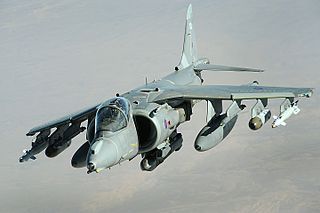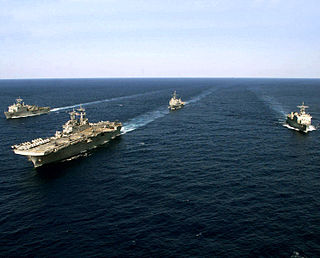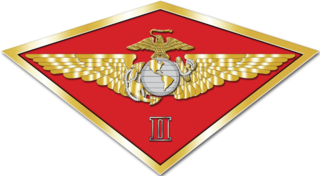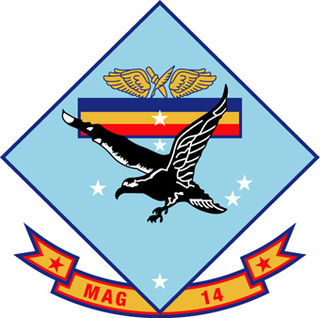
The Hawker Siddeley Harrier is a jet-powered attack aircraft designed and produced by the British aerospace company Hawker Siddeley. It was the first operational ground attack and reconnaissance aircraft with vertical/short takeoff and landing (V/STOL) capabilities and the only truly successful V/STOL design of that era.

The Fleet Air Arm (FAA) is the naval aviation component of the United Kingdom's Royal Navy (RN). The FAA is one of five RN fighting arms. As of 2023 it is a predominantly "rotary" force, with helicopters undertaking roles once performed by biplanes such as the Fairey Swordfish. It operates the F-35 Lightning II for maritime strike and the AW159 Wildcat and AW101 Merlin for commando and anti-submarine warfare.

The Harrier, informally referred to as the Harrier jump jet, is a family of jet-powered attack aircraft capable of vertical/short takeoff and landing operations (V/STOL). Named after a bird of prey, it was originally developed by British manufacturer Hawker Siddeley in the 1960s. The Harrier emerged as the only truly successful V/STOL design of the many attempted during that era. It was conceived to operate from improvised bases, such as car parks or forest clearings, without requiring large and vulnerable air bases. Later, the design was adapted for use from aircraft carriers.

The British Aerospace Harrier II is a second-generation vertical/short takeoff and landing (V/STOL) jet aircraft used previously by the Royal Air Force (RAF) and, between 2006 and 2010, the Royal Navy (RN). The aircraft was the latest development of the Harrier family, and was derived from the McDonnell Douglas AV-8B Harrier II. Initial deliveries of the Harrier II were designated in service as Harrier GR5; subsequently upgraded airframes were redesignated accordingly as GR7 and GR9.

An amphibious ready group (ARG) of the United States Navy consists of a naval element—a group of warships known as an Amphibious Task Force (ATF)—and a landing force (LF) of U.S. Marines, in total about 5,000 people. Together, these elements and supporting units are trained, organized, and equipped to perform amphibious operations.

Marine Attack Squadron 223 (VMA-223) is a United States Marine Corps fixed wing attack squadron that consists of McDonnell-Douglas AV-8B Harrier II (V/STOL) jets. The squadron is based at Marine Corps Air Station Cherry Point, North Carolina and falls under the command of Marine Aircraft Group 14 (MAG-14) and the 2nd Marine Aircraft Wing. The squadron uses "Stone" as its radio callsign.

The Hawker P.1127 and the Hawker Siddeley Kestrel FGA.1 are the British experimental and development aircraft that led to the Hawker Siddeley Harrier, the first vertical and/or short take-off and landing (V/STOL) jet fighter-bomber.

Marine Fighter Attack Squadron 211 (VMFA-211) is a United States Marine Corps fighter attack squadron, currently consisting of F-35B Lightning II stealth STOVL strike fighter jets. Known as the "Wake Island Avengers" and the "Bastion Defenders", the squadron is based at Marine Corps Air Station Yuma, Arizona and falls under the command of Marine Aircraft Group 13 (MAG-13) and the 3rd Marine Aircraft Wing.

Marine Fighter Attack Training Squadron 502 (VMFAT-502) is a United States Marine Corps fighter attack training squadron flying the Lockheed Martin F-35 Lightning II. Known as the "Flying Nightmares", the squadron maintains the history of Marine Attack Squadron 513 (VMA-513) which dates back to World War II and was decommissioned on 12 July 2013. The squadron is based at Marine Corps Air Station Miramar and falls under the command of Marine Aircraft Group 11 and the 3rd Marine Aircraft Wing

The 2nd Marine Aircraft Wing is the major east coast aviation unit of the United States Marine Corps and is headquartered in Marine Corps Air Station Cherry Point, North Carolina. The Wing provides the aviation combat element for the II Marine Expeditionary Force.

Marine Attack Squadron 231 (VMA-231) is a United States Marine Corps fixed wing attack squadron that consists of AV-8B Harrier (V/STOL) jets. The squadron, known as the "Ace of Spades", is based at Marine Corps Air Station Cherry Point, North Carolina and fall under the command of Marine Aircraft Group 14 (MAG-14) and the 2nd Marine Aircraft Wing.

Marine Fighter Attack Squadron 542 (VMFA-542) is a United States Marine Corps Aviation fighter attack squadron flying the F-35B Lightning II. VMFA-542 is based at Marine Corps Air Station Cherry Point, North Carolina and falls under the command of Marine Aircraft Group 14 (MAG-14) and the 2nd Marine Aircraft Wing.

Marine Aircraft Group 14 (MAG-14) is a United States Marine Corps aviation unit based at Marine Corps Air Station Cherry Point, North Carolina that is currently composed of two AV-8B Harrier squadrons, one F-35B squadron, one UAV training squadron, one KC-130 squadron, and an aviation logistics squadron.

Marine Attack Squadron 331 (VMA-331) was an attack squadron in the United States Marine Corps. The squadron, also known as the "Doodlebugs" and "Bumblebees," was part of Marine Aircraft Group 31, 2nd Marine Aircraft Wing and was based out of Marine Corps Air Station Beaufort, South Carolina. The squadron fought in World War II and Operation Desert Storm. It was decommissioned as part of the post Cold War drawdown of the US Military on 1 October 1992.

The McDonnell DouglasAV-8B Harrier II is a single-engine ground-attack aircraft that constitutes the second generation of the Harrier family, capable of vertical or short takeoff and landing (V/STOL). The aircraft is primarily employed on light attack or multi-role missions, ranging from close air support of ground troops to armed reconnaissance. The AV-8B is used by the United States Marine Corps (USMC), the Spanish Navy, and the Italian Navy. A variant of the AV-8B, the British Aerospace Harrier II, was developed for the British military, while another, the TAV-8B, is a dedicated two-seat trainer.
899 Naval Air Squadron was a squadron of the Fleet Air Arm of the United Kingdom.

Arthur Tomassetti is a retired United States Marine Corps colonel, combat veteran, and test pilot who is notable for his work on the Joint Strike Fighter (JSF) and F‑35 Lightning II. During twenty-one years on the programs, he worked in key roles developing pilot interfaces, testing aircraft capabilities, fielding aircraft to operational units, and establishing the F-35 training organization that certifies US and international pilots and maintainers.
Peter Harris is a British aircraft pilot and former two star senior officer of the Royal Air Force (RAF) with extensive flying and command experience.
 United Kingdom
United Kingdom United States
United States West Germany
West Germany 























